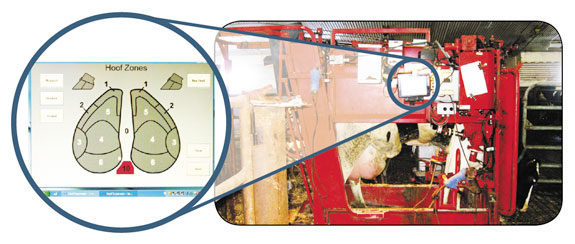Click here to read an update to this article. I have been in the hoof care business for more than 16 years and have seen my herds expand in size over and over again. The industry has integrated from mid-size herds in tiestalls and cows spending much of their time on pasture to larger freestall operations with cows spending most or all of their time walking on concrete.
During this time, cow comfort has improved dramatically through stall size and design, ventilation, water access, etc., in these larger modern enterprises. In most cases these improvements have made cow comfort better in these larger farms, but concrete can never replace the cushion and relief that time on pasture can provide.
Also, concrete does not have the forgiveness that pasture provides on a cow’s hooves that have become overgrown or out of balance, but that does not mean we need to have to accept a higher incidence of lameness in our modern dairy barns or that we can’t have happy, healthy cows in these types of environments.
However, it does take a lot more effort, management and good accurate recordkeeping to make sure we are keeping our cows healthy, productive and profitable. The days of trimming the cow once or even twice a year are gone.
We need to provide the individual care that was more easily accomplished when there were only 50 to 100 cows to keep track of. Then it was easy to just have us hoof trimmers come twice a year or, more ideally, every five months and do a whole-herd trim.
Most of my larger herds prefer to have a weekly, bi-weekly or monthly appointment. That is why I decided, as a hoof trimmer, I needed to help in the record-keeping department and decided to invest in a “chute-side” computer system to record the cows trimmed and the lesions observed on the hooves.
Now, at the end of the trim session, there are detailed individual cow reports and easy-to-read herd summaries. These reports could be shared and viewed by everyone involved in the herd’s health, including the vet, nutritionist and other farm consultants.
There was no longer a “communication breakdown” from what was actually seen on trim day and what got reported back to others not present on trim day. It was also amazing how quickly most of my clients started to look at hoof health in their herds.
The clients and their employees were now starting to focus on the “real” issues and not the “perceived” issues in regards to hoof health. I was able to gain trust and take more control to make sure the cows that needed extra attention were put on a re-check trim list.

Over the following year, as I got more cows in my chute-side computer system (Hoof Supervisor), I quickly began to notice that even in my best-managed herds, we were missing some cows that should have been trimmed sooner.
In most of my herds the trimming protocol was to perform the first trim in the lactation within the first 100-150 DIM (days in milk) and again just before dry-off.
The results of this protocol can be seen from one of my clients where in June ’08 ( Figure 1 ) the herd had a lameness incidence as high as 44 percent.

In less than a year, by following the trim protocol, we were able to lower the lameness incidence to about 10 percent ( Figure 2 ).
In a perfect world, when all cows freshen every 12 to 13 months, this protocol would probably work well and be sufficient, but what about those cows that take 200+ days to get pregnant?
I began wondering what else I could do to help my clients to achieve a lameness incidence less than 5 percent.
I kept coming back to the small herd mentality and individual cow care.
More easily said than done when we are talking about hundreds of cows to keep track of and much of the daily work done by hired employees, but I figured with the many dairy management software programs on the market today such as DC305, PC Dart, VAMP, etc., this should be possible.
By making another investment in my business with one of these software programs, we were able to interface more lactation information into the chute-side computer system and were able to monitor hoof health by DIM, pen ID, lactation, etc., ( Figure 3 ).

We were now able to quickly see where most of the hoof issues were occurring and at what stage in the lactation. This makes it possible to quickly decide where the problem is most prevalent and to help my clients to quickly make changes or improvements in their operation to improve the overall health of the herd.
I was also now able to customize a trimming protocol for each of my clients and, more importantly, each individual cow. I am now trying to create all my clients’ maintenance (preventive) trim lists so all my client needs to do for trim day is add any cows showing signs of lameness.
My protocol now is to perform the first trim of the lactation between 80-120 DIM and the dry-off trim for all cows with days carrying calf (DCC) greater than 189 days and days since last trim (DSFTR) greater than 40 days. The third trim command is where it is customized for each client depending on the rate of hoof growth compared to hoof wear from the facility.
For the majority of the herds, this is set at DIM>100 and DSFTR>150 days (five months), since in most cases every six months seems not to be sufficient for optimal hoof health.
In herds that have facilities that cause more wear, this command is changed accordingly to DSFTR>180-200 days. For clients that have invested in rubber on the concrete and the rate of growth exceeds the rate of wear, the command may change for the second trim to DSFTR>120 days.
Those individual cows in the herd that need to be trimmed more frequently than the default for the herd or are prone to lameness are put on a re-check list in the chute-side computer system, possibly to be trimmed every 80-90 days.
With these commands all cows are ensured to have a balanced foot before they hit peak production; they have a balanced healthy foot going into the dry period and more of a guarantee that no cows go more than 150-200 days any time during their lactation without having their foot checked to make sure it is healthy and in balance. A year later, on this same trim protocol, this herd’s lameness incidence was down to 4 percent.
By keeping good records, monitoring results and providing “individual cow care” in a large-herd environment, this herd came from 98 percent of cows showing some kind of hoof lesion and a 44 percent lameness incidence to only 42 percent of the cows showing a hoof lesion and only a 4 percent lameness incidence.
Any herd can achieve these results with a good preventative, maintenance hoof trimming protocol. For hoof trimmers, there are now starting to be a few choices in the market for a chute-side computer system that fits your needs and budget. There is even more of a variety of choices in the market for a dairy management software program that can aid in the individual cow care needed.
Work with the software company, their technical support advisers and your hoof trimmer to customize a trimming protocol that works for your dairy. With the herd owner/manager, hoof trimmer, nutritionist and farm employees working together, it is achievable to provide that “individual cow care” needed in a large-herd environment to ensure happy, healthy cows.







